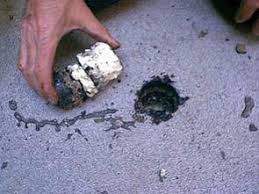The complexities involved in adequately designing a roof for optimal long-term performance are reflected by the number of factors that a designer must consider, including:
- original construction and life-cycle (long-term) costs;
- energy conservation scheme;
- value of building’s interior contents;
- required long-term service life;
- basic roof components (deck, insulation, membrane, accessories);
- availability of qualified contractors/workers;
- environmental factors;
- jurisdictional building practices; and
- climate zone.
The choices made for every single factor can affect multiple of other factors. This creates a huge number of opportunities for bad choices and problems. In designing a successful roof system, the choices made for all of the factors listed above must be accurate. A successful roof design also depends on whether it meets local building code, and, oftentimes, also insurance company requirements.
Assignment of Responsibilities for Low-Slope Roof Construction

The following is a general description of the division of responsibilities and typical sequence for design and construction of a low-slope roof.
- An architect specifies roofing components and installation methods. The architect may also provide progress and final inspection reports. In making decisions, the architect will typically confer with:
-
- the building’s mechanical engineer about moisture issues, heating and cooling loads, roof-mounted mechanical equipment, and any related roof penetrations.
- the structural engineer to ensure adequate roof slope and strength/rigidity of the roof structure to prevent deflection (sagging), which can cause ponding.
- the building’s owner in designing a periodic maintenance and inspection schedule (often a warranty requirement), along with a budget for the project.
- Products are purchased, transported to the job site, and often stored.
- The general contractor supervises material storage, and controls scheduling and coordination among the various subcontractors (HVAC, electrical, etc.), whose work interfaces with or affects the roof. The general contractor is also responsible for supplying the roofing contractor with an acceptable roof deck, and may supply the means for transporting materials from the ground to the roof.
- The roofing sub-contractor installs the roof assembly components according to the architect’s specifications.
-
- Warranty terms often require inspection by the weather membrane manufacturer, especially with single-ply membranes.
- Warranty terms may require that the roofing subcontractor provide specific certifications or pre-qualification.
Assignment of Responsibility for Low-Slope Roof Failures
The following sequence of events leading to roof failure is not uncommon and is an example of the difficulty involved in assigning fault for problems encountered during the inspection of low-slope roofs.
- The designer, relying on the integrity of a pre-qualification and the roofing manufacturer, skimps on roof-system specifications and details.
- The general contractor, disregarding both the roofer’s qualifications and the application method specified by the architect, accepts the lowest roofing bid and depends on the manufacturer’s inspections to ensure that the roof assembly is properly installed.
- The roofing contractor exercises his option to purchase cheaper products that still meet specifications and warranty requirements.
- The manufacturer’s representative responsible for inspecting the work is often the sales representative who sold the materials to the roofing contractor and is depending on that contractor for future sales. Because of this inherent conflict of interest, he may be hesitant to identify borderline issues that may or may not turn out to be problems.
Accurate determination of where responsibility lies is often difficult without invasive measures that lie beyond the scope of the International Standards of Practice for Inspecting Commercial Properties (ComSOP). Commercial property inspectors may exceed the scope of the standards at their own discretion and with the consent of – and according to terms of the agreement with – the building owner.

Low-Slope Roof Core Sample
Invasive measures, like core sampling, are typically performed in conjunction with a qualified roofing contractor, either the contractor having the contract to perform roofing maintenance on the building or a third party, such as someone on the commercial inspector’s team of specialty consultants.
The Takeaway for Commercial Property Inspectors
Commercial property inspectors are not responsible for assigning responsibility for failures, but only for identifying that failures – or potential failures – exist. Exceeding the standards means assuming additional liability, and this should be reflected in the inspection fee. Commercial property inspectors will most often work as the building owner’s representative to eliminate any possible conflict of interest, as discussed earlier.
The International Standards of Practice for Inspecting Commercial Properties (ComSOP) requires inspectors to perform an inspection that meets the needs for periodic maintenance and inspection schedules for the roof system. Periodic maintenance and inspection schedules are designed to identify issues, such as clogged drains, ponding, and the integrity of flashing and membranes, as well as splits, bare spots, blisters, lap-seam openings, and other defects that, over time, will drastically compromise the roof system.
Although commercial property inspectors can’t perform maintenance personally, they should acquire information from the building owner about the periodic maintenance and inspection schedule. If one is not in place, they can assist the owner in establishing one. Depending on the condition of the roof and the needs of the client, this may include researching the building’s historical documents. Along with periodic maintenance and inspection schedules, understanding the construction of low-slope roofs and the assignment of responsibility for failures will also help inspectors perform before-and-after construction inspections to help determine whether damage occurred from maintenance or repair work performed.
Additional Commercial Inspector Resources:
Inspecting Low-Slope Roofs Course for Commercial Property Inspectors
Low-Slope Roof Components
The History of Low-Slope Roofs
Commercial Property Inspection Technical Course (Live)

